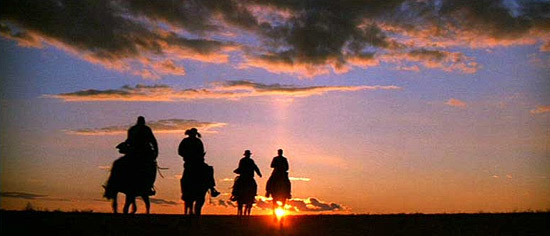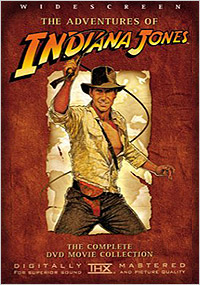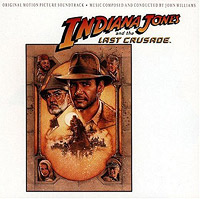THE INTERVIEW
This segment of the article features a Q&A with author and film historians Scott Higgins, Eric Lichtenfeld, Joseph McBride, and Jonathan Rinzler. The interviews were conducted separately and have been edited into a “roundtable” format.
Scott Higgins is Associate Professor of Film Studies at Wesleyan University, where he teaches several film courses including Cinema of Adventure and Action. His books include Harnessing the Technicolor Rainbow: Color Design in the 1930s, (University of Texas Press, 2007), Arnheim for Film and Media Studies (Routledge, 2010), and the forthcoming Matinee Melodrama.
Eric Lichtenfeld is the author of the book Action Speaks Louder: Violence, Spectacle, and the American Action Movie (Wesleyan, 2007), an authoritative and entertaining study of the action film genre. In addition, he has written about film for Slate and The Hollywood Reporter, and moderated panel discussions for the Academy of Motion Picture Arts and Sciences (including a 2011 screening of Raiders of the Lost Ark) and the American Cinematheque. He has taught film at Loyola Marymount University, UCLA, Wesleyan University, and the Harvard School of Law. Eric has also contributed supplemental material for several DVD and Blu-ray releases, including Speed, Predator and Die Hard.
Joseph McBride is the author of Steven Spielberg: A Biography (Simon & Schuster, 1997; University Press of Mississippi, 2011, second edition; Faber & Faber, 2012, third edition; Chinese translation published in Beijing in 2012). A professor in the Cinema Department at San Francisco State University, McBride has written several other books, including Into the Nightmare: My Search for the Killers of President John F. Kennedy and Officer J.D. Tippit (Hightower Press, 2013), Frank Capra: The Catastrophe of Success (University Press of Mississippi, 2011), Searching for John Ford (University Press of Mississippi, 2011), Whatever Happened to Orson Welles?: A Portrait of an Independent Career (University Press of Kentucky, 2006), and Writing in Pictures: Screenwriting Made (Mostly) Painless (Vintage, 2012). He was a co-producer on the documentary Obsessed with Vertigo: New Life for Hitchcock’s Masterpiece and a co-writer of the screenplay for Rock ‘n’ Roll High School (1979).
Jonathan Rinzler is the executive editor of LucasBooks, the publishing division of Lucasfilm Ltd., and the author (with Laurent Bouzereau) of The Complete Making of Indiana Jones: The Definitive Story Behind All Four Films (Ballantine/Del Rey, 2008). He has also written several Star Wars and Lucasfilm-themed books, including The Making of Star Wars (Ballantine/Del Rey, 2007), The Making of The Empire Strikes Back (Ballantine/Del Rey, 2010), The Making of Return of the Jedi (Ballantine/Del Rey, 2013), The Sounds of Star Wars (Chronicle, 2010), and Star Wars: The Blueprints (47North, 2013).

L to R (above): Scott Higgins, Eric Lichtenfeld, Joseph McBride & Jonathan Rinzler
Michael Coate (The Digital Bits): Indiana Jones was the most successful 1980s movie franchise? Why?
Scott Higgins: Partly, the answer is timing. All three Jones films were released in the 80s vs. only two of the Star Wars franchise.
Eric Lichtenfeld: They weren’t just great movies; they were also great experiences. And each was a great experience in its own way—more or less. And the movie—especially the first and third—lend themselves to both repeat viewings and to all audiences, so you could go back and back with different groups and kinds of the people in your life.
Joseph McBride: It brought back old entertainment values tried and tested in the thirties and earlier—serials and B movies. But on bigger budgets and with better actors. It came at a time when movies were being dumbed down and focused on juvenilia in synch with the times (the Reagan era) and when Hollywood was turning its back on personal filmmaking in favor of self-conscious genre homages (i.e., rip-offs).
Jonathan Rinzler: You had the best of the best on the crew and at ILM—and then you had two geniuses at the top in Lucas and Spielberg. And sometimes an actor gets the role they were born to play, and that seems to me to be true for Harrison Ford as Indiana Jones.
Coate: How are the Indiana Jones movies significant within the action-adventure genre?
Higgins: It is interesting that you should specify “action-adventure” rather than “action” as the genre in question. I think our conception of “action-adventure” as a distinct part of the action film tradition comes largely from the Indiana Jones films. Part of what makes them “adventure” is tone—they are throwbacks to Fairbank’s Thief of Bagdad and Flynn’s Adventures of Robin Hood in their broadly drawn subsidiary characters, gleefully obvious comedy, and basic sincerity. These films are rollicking, in a way that adult-oriented action films were not. For better or worse, they created a model for the “family actioner”—movies pitched broadly enough to play cross-generationally, but still crafted around physical problem solving and violent encounters. I guess I’m describing the basic tent pole film—and it has served the industry well (Independence Day, Avengers) and disappointed terribly (Wild, Wild West, anyone?). The Indiana Jones films didn’t invent this approach, but they carried it off with originality and set a certain standard.
The Indiana Jones films are also important as an American answer to Bond, which is probably the century’s most important action franchise. It is clear that Spielberg and Lucas were emulating Bond, replacing 007’s romantic and exotic Britishness with an equally romantic and exotic nostalgia for America during the good war. Jones substantially cleaned up Bond’s sexuality, but kept his humor and physical cleverness.
If you think of the landmarks of the contemporary action film, Raiders definitely belongs among the fantasy-oriented trend: Star Wars, Superman, Terminator, The Matrix, etc.
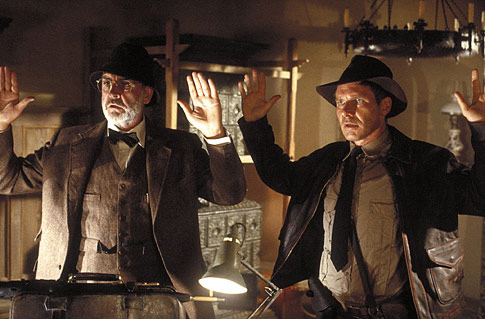
Lichtenfeld: Strangely, I’ve always seen them as something apart from the action-adventure genre. At the time the first three were released, they didn’t really look like the rest of the genre. After all, this was still the era of the R-rated action movie that generally didn’t have the scope or craftsmanship of the Indiana Jones movies.
McBride: Steven Spielberg has a genuine kinetic gift for cinematic action. With Raiders, he was moving fast and working economically to overcome the reputation for overindulgence he had acquired with the bloated 1941, so Raiders benefits from that zip and efficiency and a certain amount of visual and verbal wit (the latter thanks to Lawrence Kasdan’s screenplay). But Raiders is marred by its racist and neocolonialist viewpoint. It was the perfect film to start off the Reagan era in Hollywood studio filmmaking, a miserable period. Spielberg faltered even more badly, in my view, with Temple of Doom, which is so shrill, gross, and racist that it is a deeply embarrassing work. Ironically, that very grossness has made it something of a cult favorite among the undiscriminating. I like the third film in the series, Last Crusade, because instead of Third World villains, it has villains we can all despise (Nazis) and has a visual spaciousness and energy and wit that seems more relaxed than the previous entries. And it has that fascinatingly complex father-son tension between Indy and his Dad (Sean Connery), which goes to the heart of Spielberg’s thematics. I even sort of like Crystal Skull, with all its absurdity, because I believe Spielberg approached it as a lark, a framework for spoofing his earlier work systematically, genre by genre. I even like the “nuking the fridge” scene and especially the self-satire of immolating the iconic Spielberg suburban home.
Rinzler: With the Indy films, Spielberg and Lucas created the film-as-Disneyland-ride. Of course the films have story and character—but at a certain point, usually about a third of the way through, Indy films become like rides—just nonstop fun and adventure and thrills.
Coate: How do the Indiana Jones movies pay homage to and improve upon the serials that inspired them?
Higgins: The Jones films draw iconography and plot devices from serials and studio-era B adventures more generally. Lucas and Spielberg wanted to recapture the thrills they remembered experiencing in local revival houses when they were growing up, and so these films are steeped in nostalgia for an older cinematic language. Like serials of the 30s-50s, the Indiana Jones films have a sort of crackpot optimism set alongside stunning depictions of depravity. Like serials, the Indiana Jones films can fail to make sense on a very basic level. Like serials, they cover plot holes by simply speeding forward through stunts and chases.
Unlike the serials, the Jones films tend to be unified, coherent, and centered on psychologized characters. In other words, these are feature films, and they are far more tightly plotted than, say, Captain Midnight. Also, unlike most serials, Indiana Jones has the benefit of huge budgets. Spielberg can realize warhorse serial set pieces, like the rope bridge, the crushing room, the abandoned airplane, the ritual sacrifice, or even the horse/car chase and booby-trapped temple at a much, much higher level than the B serials. What those original movies lacked in budget they made up for in cockeyed ingenuity. In serials, Spielberg and Lucas found a storehouse of ideas that they could raid and renew. Incidentally, the Bond franchise first inherited and embellished the serial’s territory, so Indiana Jones is re-appropriating it to American shores.
I think the Indiana Jones films are most successful in emulating the serials’ relentless rhythm of action. Raiders hits a serial-like tempo of stunt-per-minute toward the end of its second act (from the snake-tomb through the truck chase). In Doom, it feels like the filmmakers realized this was their most successful sequence, and so extended that kind of pacing across the entire second half of the film (everything that occurs underground through the climax). That decision made the second half of Doom hard to beat in terms of action and absurd spectacle. Alas, that left too much time in the first half devoted to clumsy exposition and Kate Capshaw.
Lichtenfeld: They’re structured like serials and they capture the spirit of serials, but they have real production value and, even more, craftsmanship. It’s hard to get pulpier than with Temple of Doom and yet John Williams’s score is so rich and complex, it’s practically operatic.
It’s as if these are the movies the serials wanted to be, and in that sense, they’re the fulfillment of—I was going to say “a potential” or “a promise,” but that’s not quite it, because the serials could never really hope to achieve that in their lifetime. People use movies to help them dream of being something else. If movies could dream of being something else, than the serials dreamed of being the Indiana Jones series!
McBride: There’s no comparison, as Spielberg and Lucas quickly realized when they screened old serials and realized how crummy they are. They pay homage to the idea of the old serials.
Rinzler: Like Star Wars in relation to Flash Gordon and Buck Rogers, the Indy films in relation to the Republic serials and adventure comics took the essentials out of those earlier media—fun, adventure, cliffhangers, comedy and heroism—and gave them a high-budget sheen and therefore the talents of some of the best filmmakers of their generation.
Coate: In what way is Indiana Jones and the Last Crusade worthy of celebration on its 25th anniversary?
Higgins: We should celebrate The Last Crusade, if only as a blip on our collective nostalgia radar. The film comes right at the moment that Spielberg begins to more or less mechanically “diversify” his output between prestige and popcorn/audience movies. The surrounding films all have this patina of serious ambition about them—Color Purple (‘85), Empire of the Sun (‘87), Always (yes, even Always, also ‘89). From here on, he would alternate between two kinds of film—Schindler’s List (‘93)/Jurassic Park (‘93); Amistad (‘97)/Lost World (‘97)—and we all quickly learned what to expect and not expect from him. But in ‘89 it still wasn’t entirely clear which films belonged to which camp, or even if there were two camps. We could almost expect every bit as much passion, precision, and serious engagement in Last Crusade as we (or the critics) might in prestige bait. Arguably, Jurassic Park carried on the tradition of extremely carefully wrought, audience-pleasing, genre pics, which Jaws had promised, but by then the split was clear. Last Crusade, at the time, felt like a return to form for Spielberg—a flexing of the entertainment muscle. In retrospect, it was just the first swing of the pendulum between middlebrow and populist—the bloom coming off the rose. I’m nostalgic for that rose.
But the film is also much more—it is, in fact, a good movie. A less flawed, more worthy follow up to Raiders. We should celebrate it as a fitting end to the trilogy. If we celebrate hard enough, we might erase all memory of Crystal Skull, and that sinking depression that comes with the announcement of a fifth installment.
Lichtenfeld: Last Crusade is a well-loved movie. It’s brought lots of people lots of joy. And in a way, it’s the most accessible of the first three—it’s not the capital-C classic that is Raiders or the strange, dark detour that is Temple of Doom. And because it’s not a classic like the first or a purely cinematic achievement like the second, I think that when we celebrate Last Crusade, what we’re celebrating is our own memory of it, our own ongoing experience of it—even more than we’re celebrating the actual movie itself. But is that such a bad thing? To me, those are the best things moviegoing ultimately gives us. If they’re not worthy of commemorating, then I don’t know what is.
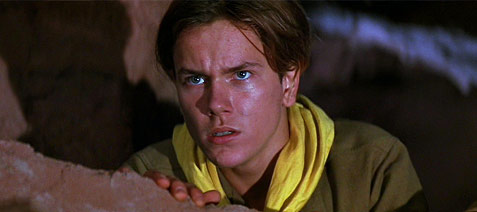
McBride: It’s the best of the four.
Rinzler: Casting Sean Connery as Indy’s dad was a stroke of genius. All the father-son material in that film is a lot of fun and so well written and acted. I really identify with a lot of those moments.
Coate: Can you recall your reaction to the first time you saw Indiana Jones and the Last Crusade?
Higgins: This movie was the end of childhood. It was an important film in that it so firmly split tastes in my family. I was raised godless, but went to the movies about every Sunday. We LOVED Jaws (seeing it first run as a seven-year-old was largely responsible for me seeking a career thinking about movies), we LOVED Raiders. But in 1989, the Higgins family tastes were running toward the high-middle. Sex, Lies, and Videotape as edgy and worthy, Born on the Fourth of July was meaningful, When Harry Met Sally… was, somehow, old fashioned and respectable. Away from the family, I was either plunging into the abyss of complete pretension (The Cook, The Thief, His Wife, and Her Lover) or seeing unredeemable crap (Friday the 13th Part VIII, Halloween 5). So, I get to Last Crusade and find the film gripping—especially the final reel with the three trials in the cave. When the lights came up, the official family opinion was “well THAT was crap… he just made that for the money….” Ouch. We were no longer on the same page.
I should have fought the fight. I actually enjoyed the damned thing… but it was my last year of college and neither my trendoid college friends, nor my homestead made it seem like the film was worth defending. It did fine at the box office without pleasing either group. Looking back, it was a learning experience—that cinematic pleasure is worthwhile wherever you get it, and that putting ideas first usually leads you astray. But the carefree days of my Spielberg childhood were over.
Lichtenfeld: It’s funny; I have a much more vivid memory of the second time I saw it. And mainly what I remember from that second trip was the sensation of my heart stopping when I realized that I’d left for the theater with my date but not my wallet.
McBride: I was pleasantly surprised. I reviewed it for Variety. I hadn’t much liked Raiders and actively disliked Temple of Doom. Last Crusade seemed far superior.
Rinzler: I think I saw it in France and I really, really had a good time. When they rode off into the sunset I thought it was a great end to the trilogy.
Coate: What did Indiana Jones and the Last Crusade do well? What were the negative or disappointing aspects, if any?
Higgins: Last Crusade does set pieces beautifully. With the possible exception of the Circus Train Chase (which I can’t get behind because… it is a Circus Train), each is loaded with creative gags and tightly executed. The Cowboy vs. Tank fight deserves serious analysis by today’s action filmmakers. It has two things that seem so sadly lacking in current, assaultive, aesthetics: Rhythm and Variation. Indy faces a series of diagrammatically clear physical dilemmas and overcomes them through clever chains of cause-and-effect. And the stunts/gags modulate between epic heroism, comic fisticuffs, and skin-of-the-teeth brutality. All the while, that tank is trundling along—straight toward the end of the desert. Honestly, it is a great piece of work—we need more of it. The Road Warrior also had it, but today only The Fast and the Furious seems to be plowing that field.
It also does hanging miniatures and matte paintings beautifully. The shot of the Zeppelin as Henry and Indy head across the tarmac is breathtaking and handcrafted—well worth putting up with all the matte lines around the airplanes and the crashing tank, etc. Incidentally, the production design is top notch all around.
It also does serials beautifully. I admire the specificity of the Last Crusade’s homage to Republic Pictures. One of Republic’s standing sets was this cave/cavern space. They used it tirelessly in The Lone Ranger, Zorro’s Fighting Legion, Jungle Girl, Perils of Nyoka. The whole Raiders trilogy is, in a way, a love letter to that cave set. We keep coming back to it, variously redressed and repurposed, across the series. The pertinent serial here is Jungle Girl (1941), which features ‘the cave of Nacros”—a booby-trapped cave that houses a chest of diamonds, guarded by fierce Lion Men warriors and concealed behind a secret sliding door. Trespassers are variously swept from the cavern and through the cliff face by a rushing torrent of water, entrapped in a chamber of poison gas, locked in a room with a retracting floor above a bottomless pit, and forced onto a diamond crushing conveyor-belt contraption. Last Crusade also borrows from Perils of Nyoka (1942), a Middle-Eastern Western with locations like “the Temple of the Moon God” and “The Valley of the Tauregs” shot on Republic’s ranch and cave set. I like to think that the final few shots of Last Crusade, in which Indy and gang ride into the sunset, leaving Petra behind them, honors Republic Pictures, where almost all serial genres ended up as Westerns in disguise.
The film also does the “professor’s fantasy” beautifully. Today, the moment that Indie ducks out of office hours, through his window, and immediately commences an adventure is intensely fulfilling for me.
Alas, the film does the “2000-year-old-man routine” rather badly. Maybe it is the fact that he speaks modern English, his unintentionally funny swordsmanship, or that the makeup and concept remind me of Mel Brooks, but Indy’s discovery of the ancient knight breaks the spell for me. Also, I’m not entirely fond of the Circus Train prologue, but at least it is thematically important and a nice glimpse of River Phoenix’s movie-star chops. He could easily have grown up to be Leo or Brad.

Lichtenfeld: The greatest strength of Last Crusade is its tone. This movie returned the fun and breeziness to the series. Fairly or not, Temple of Doom is widely seen as when the franchise went off the tracks (an apt image considering the movie’s signature mine car chase). It just has so much darkness and gore and outright weirdness. Last Crusade corrects for that.
That’s not even a full accounting, though. Last Crusade may have a light touch—even lighter than Raiders’—but it also has resonance in just the right places. It’s light without being insubstantial. In that sense, it’s Spielberg at his most “Spielberg.”
But at the same time, there’s something about this that has always felt a little calculated, even machined, to me. Maybe that’s because the movie is so obviously a correction for Temple of Doom. Last Crusade is safe, whereas Temple of Doom (whatever else you want to say about it) is gutsy. And Temple of Doom also looks like a movie—a great big, all-out movie, a spectacle—while visually, Last Crusade comes off as the smallest of the original three. Its style isn’t as distinctive; its set pieces aren’t as conceptual or as memorable. (With the arguable exception of the circus train sequence.) It reminds me a little of what Harrison Ford says in a certain other movie: “She may not look like much, kid, but she’s got it where it counts.”
So it’s a little bit of a mixed bag. But all mixed bags should be as good and as enjoyable as this one is.
McBride: The one negative aspect for me is a rather bland heroine.
Rinzler: See [my previous comments].
Coate: In what way was Professor Henry Jones (Sean Connery) an effective and/or memorable character?
Higgins: The role starts as an extremely satisfying bit of stunt casting and becomes a breathing character. Connery works by both playing against Bond (fuddy-duddy academe) and being Bond almost despite himself (bedding Elsa). The fighter-plane-strafing scene replays bits of the helicopter-strafing scene in From Russia with Love, but with a far cleverer payoff. Professor Henry has Bond’s problem-solving panache, but in an extraordinarily fusty way. That is brilliant.
Also, though the ancient knight seems like a misfire, Connery’s reaction to the ancient knight is priceless. They have this momentary recognition of one-another’s iconic greatness, before the cave starts falling in and Indy pulls them apart.
Lichtenfeld: Of all the characters, Henry Jones most embodies the movie’s overall tone. Much of its lightheartedness and its pathos stem from him. I think that’s why he’s more important than your typical supporting character. He’s like the whole movie distilled.
He’s also interesting in that he provides comic relief in some distinctly different ways. Sometimes it’s through his wry disapproval of Indy. Other times it’s through his sheer enjoyment of what’s happening around him—an enjoyment that captures the schoolboy giddiness Elsa refers to.
And these reactions are important because they’re the same ones we’re having in the audience. So he’s like our representative up on the screen. It’s like he’s speaking for us inside the movie. And each time he does it, each time we see ourselves in him—or him in us—the pleasure we get from that is like the movie rewarding us for our exuberance.
Coate: In what way was Elsa Schneider (Alison Doody) an effective and/or memorable heroine, and in what way was Walter Donovan (Julian Glover) an effective and/or memorable villain?
Higgins: She’s no Marion Ravenwood. But then, she’s no Willie Scott. On balance, I’m more grateful that she’s no Willie Scott.
Lichtenfeld: I don’t know if Elsa Schneider and Walter Donovan are memorable characters so much as they are effective ones. The way they’re sketched and performed, they harken back to their B-movie ancestors, but with much more craft and finesse. In other words, they might be stock, but they’re not cardboard. And that makes them well suited for an Indiana Jones movie!
Coate: Where does each Indiana Jones movie rank among the series? Among director Steven Spielberg's body of work?
Higgins: Raiders is clearly the best of the series. Jaws is the best of Spielberg’s genre films, with Raiders just under that.
Lichtenfeld: Ranking the Indy movies is harder for me than it should be. On the one hand, Raiders is clearly a masterpiece that leaves Temple of Doom and Last Crusade duking it out for second place. I’d give the edge to Temple, because it may be much more flawed than Crusade, but it’s also more daring. And it looks and feels like a movie with a capital M. Crusade, on the other hand, feels less ambitious. And while it’s a much more polished machine than Temple, it’s also a little too safe. It’s very enjoyable, but Temple is more sumptuous, and of the sequels, it’s the one I respect most.
On an (even more) subjective level, though, I’ve seen Raiders so many times, and studied it so closely, that if I had to pick one to see on the big screen right now, it would be Temple. In fact, whenever the movies are screened in Los Angeles, it’s Temple that’s the draw for me — and I say that having been the host and moderator for the Academy of Motion Picture Arts and Sciences’ 30th anniversary celebration of Raiders of the Lost Ark!
McBride: I know many Spielberg fans love these movies, but to me they are second- or third-tier works.
Rinzler: I like Raiders best, then Crusade, then Temple, then Crystal. Among director Steven Spielberg's body of work? I think the first three are among his best work, though for me his best material is: Duel, E.T., Jaws, Close Encounters, but his later work is great, too.
Coate: What did Indiana Jones and the Last Crusade contribute to the summer 1989 movie-going season?
Higgins: Summer ‘89 was a sequel fest: Lethal Weapon 2, Ghostbusters II, and I think Crusade is the best of the lot—maybe because the franchise had purged itself on Temple of Doom. Looking at the box office returns, I can’t argue with Crusade’s place at number 2, behind Batman. But then it was the end of my childhood, apparently. Don’t forget, though, 1989 was also the year of Road House—brilliance was in the air.
Lichtenfeld: This is a hard question to answer objectively, mainly because of nostalgia. I think that for movie-lovers of a certain age or generation, the summer of 1989 stands out as one of those summers. It was just so stuffed with movies. Big ones such as Indy, Batman, Lethal Weapon 2, and The Abyss. Surprises such as Do the Right Thing and Sex, Lies, and Videotape. And even the disappointments, which still belonged to big franchises including Ghostbusters, Star Trek, The Karate Kid, James Bond. Indiana Jones and the Last Crusade was a bright spot in that crowded field. It was also an early entry that set that feeling of bigness.
To me, that summer was the biggest and one of the last really special times when the movies would linger in the imagination long after they opened. If you were a kid back then, you could see Indiana Jones, go to sleepaway camp for a month or more, and when you came back, the movie would still be playing. At the very least, people would still be talking about it.
Now, look…some of that is nostalgia talking. Some of that is the fact that this kinds of movie will resonate with that 14-year-old differently than it will with a 40-year-old. Those things are definitely true. But what’s also true is that the industry has changed. Movies are distributed and marketed differently than they used to be. Tentpoles are packaged as huge events that then burn through screens so damn fast. And the market becomes so crowded with these things that a few weeks after one of them opens, it’s like it never even happened.

Last Crusade made just 15 percent of its total domestic gross in its opening weekend. This means that the movie had legs. It kept going and going. The other hugely successful movies of that summer—Batman and Lethal Weapon 2—did around the same thing. Last summer’s biggest action/adventure movies? Iron Man 3, Man of Steel, and Fast and Furious 6? All of those movies made over 40 percent of their money in just those first few days. And it’s not that they were unsuccessful; they were hugely successful! They just didn’t stay around. They couldn’t. Virtually nothing can. The conditions aren’t there; they’ve changed.
So to me, the real question is not so much, “What did Last Crusade contribute to the movies of Summer 1989?” To me, the real question is, “What did Summer 1989 contribute to your life as a movie-lover?” And the answer is this: it was a time when I began to really think about film and follow the industry and when big, fun, crowd-pleasing movies had the space to feel like they mattered. I’m really glad I had that.
Coate: Should there be more Indiana Jones movies?
Higgins: NO.
Lichtenfeld: It’s tempting to say yes. Who wouldn’t want to hear The Raiders March issuing from a movie theater sound system again? But there probably shouldn’t be. Rightly or wrongly, the fourth one is a much maligned movie, but one moment I’ve always liked a lot is when Indy’s friend says, “We seem to have reached the age where life stops giving us things and starts taking them away.” At this point, it may be that the most graceful thing the franchise can do is resist the urge to prove that idea wrong.
McBride: Hopefully not.
Rinzler: If the public wants them, yes.
Coate: What is the legacy of Indiana Jones and the Last Crusade?
Higgins: Last Crusade will always shine as the final film of the Jones trilogy. It is a fitting end to the series—thank god they didn’t make another!
Lichtenfeld: For a movie as well-loved and fondly remembered as this one is, that’s also a hard question to answer—partly because Kingdom of the Crystal Skull really complicates the whole picture.
Last Crusade plays like the end of a trilogy (even if it wasn’t truly a trilogy per se). And starting in ’81, and ending in ’89, it was series that encapsulated the decade, a decade which George Lucas and Steven Spielberg helped define, no less. So Last Crusade—especially the end—has a real feeling of summation. But now there’s this fourth movie: a sequel largely rejected by fans who now double-down on the idea that the first three constitute the trilogy!
It’s also hard to answer because, of the first three movies, it’s the one that least has its own identity. It’s clear how large the other two loom over it. It’s a very self-conscious reversal of the course set by the second one. It’s also a very definite throwback to the experience and the fun—and the world and the story structure—of the first one.
So in the end, it may be that the legacy of Last Crusade is that you can go home again—while the legacy of Crystal Skull will be that you can’t.
Coate: Thank you, Scott, Eric, Joseph, and Jonathan, for sharing your thoughts on Indiana Jones and the Last Crusade on the occasion of the 25th anniversary of its release.
---
PRINCIPAL CAST & CREW:
- Indiana Jones – Harrison Ford
- Professor Henry Jones – Sean Connery
- Marcus Brody – Denholm Elliott
- Elsa – Alison Doody
- Sallah – John Rhys-Davies
- Walter Donovan – Julian Glover
- Young Indy – River Phoenix
- Director – Steven Spielberg
- Producer – Robert Watts
- Screenplay – Jeffrey Boam
- Story – George Lucas and Menno Meyjes
- Executive Producers – George Lucas, Frank Marshall
- Music – John Williams
- Editor – Michael Kahn, ACE
- Director of Photography – Douglas Slocombe
- Production Designer – Elliot Scott
- Costume Designer – Anthony Powell with Joanna Johnston
- Casting – Maggie Cartier; Mike Fenton, CSA; Judy Taylor, CSA; Valorie Massalas
- Visual Effects Supervisor – Micheal J. McAlister
- Sound Designer – Ben Burtt
- Sound Mixer – Tony Dawe
- Supervising Sound Editor – Richard Hymns
- Re-Recording Mixers – Ben Burtt, Gary Summers, Shawn Murphy
- Distributor – Paramount
- Production Company – Lucasfilm Ltd.
- Release Date – May 24, 1989
- Running Time – 127 minutes
- Projection Format – Scope / Dolby Stereo
- MPAA Rating – PG-13
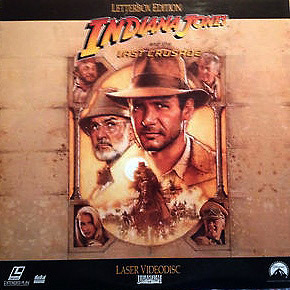
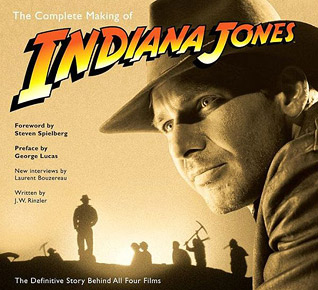
SPECIAL THANKS:
Chris Argyropoulos, Jim Barg, Bert Branson, Raymond Caple, Daily Bruin, Nick DiMaggio, Axel Fransberg, Bobby Henderson, Scott Higgins, Brendan Hornbostel, Bill Kretzel, Eric Lichtenfeld, Lucasfilm Ltd., Joseph McBride, Jim Perry, Jonathan Rinzler, Tim Schafbuch, Kristen Taketa, University of California Los Angeles, and a huge thank you to all of the librarians who helped with the research for this project.
SOURCES/REFERENCES:
Numerous newspaper articles, film reviews and theater advertisements; the periodicals Daily Bruin, The Hollywood Reporter, Newsweek, Time, and Variety; the website Boxofficemojo, the books The Complete Making of Indiana Jones: The Definitive Story Behind All Four Films (Ballantine/Del Rey, 2008) and George Lucas’s Blockbusting: A Decade-by-Decade Survey of Timeless Movies Including Untold Secrets of Their Financial and Cultural Success (George Lucas Books/Harper Collins, 2010); the motion picture Indiana Jones and the Last Crusade (1989, Lucasfilm Ltd./Paramount Pictures).
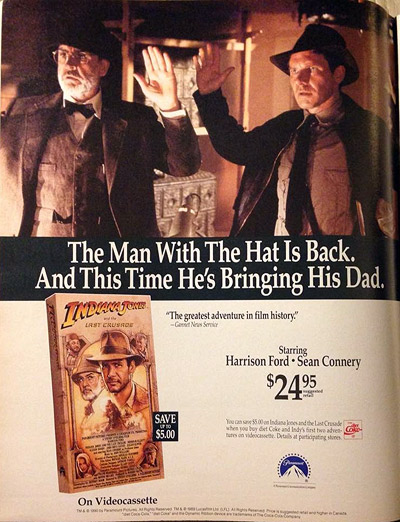
IMAGES:
Copyright 1989 Lucasfilm Ltd.
All figures and data included in this article pertain to the United States & Canada except where stated otherwise.
IN MEMORIAM:
- Robert Eddison (“Grail Knight”), 1908-1991
- Denholm Elliott (“Marcus Brody”), 1922-1992
- Elliot Scott (Production Designer), 1915-1993
- River Phoenix (“Young Indy”), 1970-1993
- Jeffrey Boam (screenwriter), 1946-2000
- Pat Roach (stunts, “Gestapo”), 1937-2004
- Michael Moore (Second Unit Director), 1914-2013
- Michael Coate
